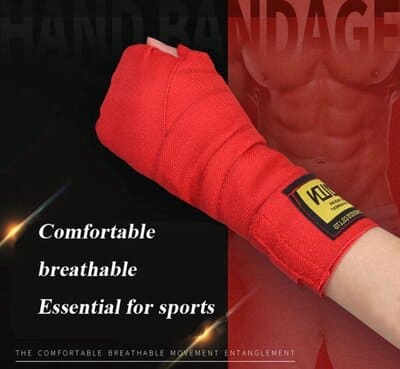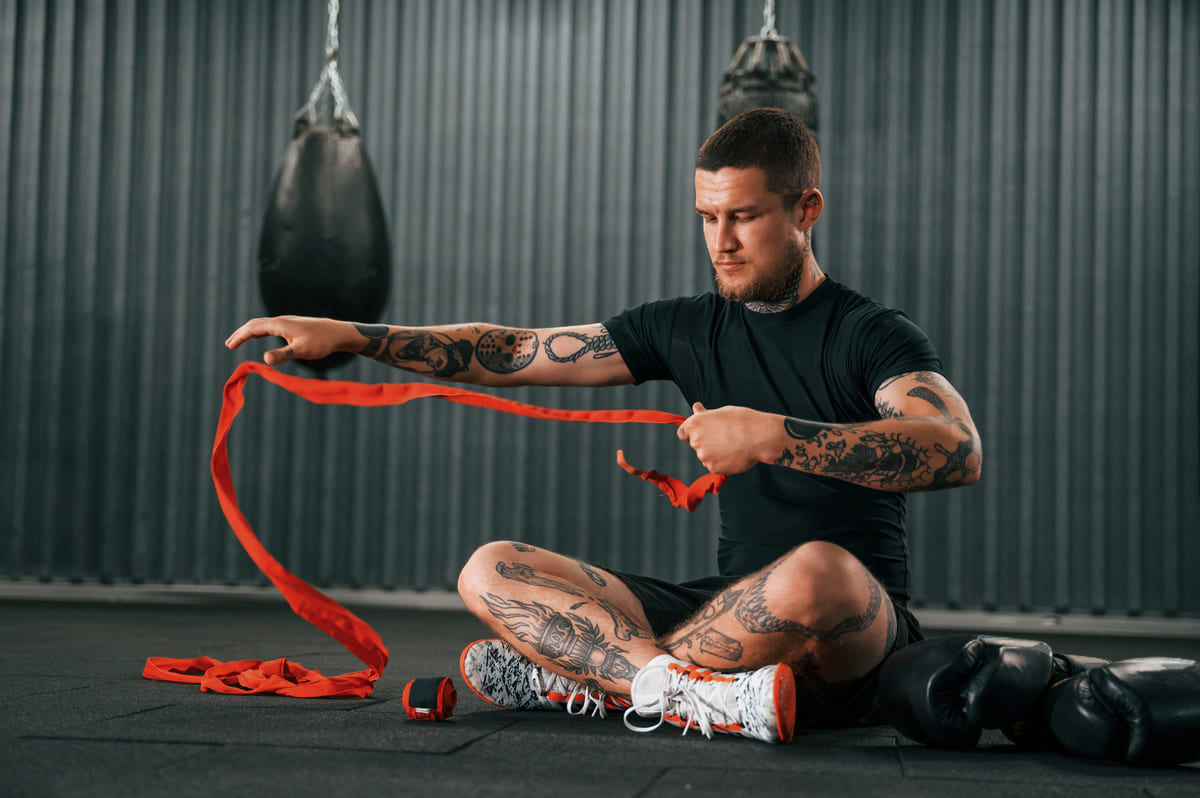Boxing is a combat sport that requires a lot of physical strength and agility. Boxers use their hands to punch their opponents, which can cause serious injuries if not protected properly. That’s why hand wraps and tape are essential for boxers to protect their hands and wrists during training and fights.
Boxers use different types of tape on their hands, depending on their preferences and the rules of the competition. The most common types of tape used in boxing are:
Cloth tape is made of cotton and is more flexible than sports tape, which is made of a non-woven fabric.
Sports tape is more rigid and provides better support, but it can be uncomfortable to wear for long periods.
Tape used by boxers for a match
Boxers use different types of tape to wrap their hands before a fight. The two most common types of tape used by boxers are adhesive athletic tape and gauze tape.

Gauze wrap
Gauze tape is another type of tape that is commonly used by boxers. Gauze tape is made of a thin, woven material that is used to wrap around the hands and wrists. Boxers use gauze tape to provide additional support and protection to their hands and wrists. Gauze tape is also used to keep the hand wraps in place.
Boxers usually apply gauze tape first, followed by adhesive athletic tape. The combination of gauze tape and adhesive athletic tape provides maximum support and protection to the hands and wrists during a boxing match.

Adhesive Athletic Tape
Adhesive athletic tape is a type of tape that is used to secure bandages, pads, and other medical equipment. Boxers use adhesive athletic tape to wrap their hands before putting on gloves. This type of tape is made of a combination of cotton and synthetic fibers, which makes it strong and durable. Adhesive athletic tape is also easy to tear, which makes it convenient to use during a boxing match.
In conclusion, boxers use a combination of gauze tape and adhesive athletic tape to wrap their hands before a fight. Gauze tape is used to provide additional support and protection to the hands and wrists, while adhesive athletic tape is used to secure the gauze tape in place.
The Importance of Hand Wrapping in Boxing
Boxers wrap their hands with tape to immobilize their delicate joints and bones, preventing them from getting injured during a fight. The tape also helps to support the boxer’s wrists and hands, improving their punches. Hand wraps and tape are permitted for the protection of hands, according to boxing rules.

Protection Against Injuries
The primary purpose of hand wrapping is to protect the hands and wrists from injuries. Boxers use hand wraps to reduce the risk of fractures, sprains, and other hand and wrist injuries. Hand wrapping provides extra support to the bones, tendons, and muscles in the hands and wrists, which reduces the impact of punches and prevents injuries.
Hand wraps protect the knuckles, which are the most vulnerable part of the hand during a punch. They also protect the wrist by providing an extra layer of support and preventing hyperextension. Hyperextension can cause serious injuries to the wrist, which can take a long time to heal and can even end a boxer’s career.
Enhancing Performance
Hand wrapping also enhances a boxer’s performance in the ring. It provides a better grip on the gloves, which increases the power and accuracy of punches. Hand wrapping also helps to keep the gloves in place, which prevents them from slipping during a fight.
Moreover, hand wrapping helps to reduce fatigue in the hands and wrists. It distributes the impact of punches evenly across the entire hand, which reduces the strain on any one particular area. This allows boxers to throw more punches without getting tired quickly.
Hand wrapping is an essential part of boxing that every boxer must do before entering the ring. It provides protection against injuries and enhances performance. Boxers should always use hand wraps that are appropriate for their weight class and skill level to ensure maximum protection and performance.
Regulations for Hand Taping in Boxing
The rules governing the use of tape during a boxing match are strict and must be followed to the letter. These vary per type of boxing but sometimes also per association.
Professional Boxing Rules
Professional boxing is governed by a strict set of rules, which vary depending on the jurisdiction. In the United States, the Association of Boxing Commissions (ABC) is responsible for establishing and enforcing the rules governing professional boxing matches. According to the ABC Regulatory Guidelines, boxers are allowed a maximum of 8 feet of tape per hand, not 6 feet as some sources suggest. The tape must be no more than 1.5 inches wide, and must be applied in a specific manner to ensure that it does not cover any part of the joints when the hand is squeezed to create a fist.
The ABC also requires that the tape be applied by a licensed professional, such as a trainer or cutman. The tape must be applied in the presence of a commission representative, who will inspect the tape to ensure that it conforms to the rules. Any tape that does not conform to the rules will be removed, and the boxer will be required to re-tape his or her hands.
Amateur Boxing Rules
Amateur boxing is governed by the rules established by the International Boxing Association (AIBA). According to the AIBA Technical and Competition Rules, boxers are allowed a maximum of 4.5 meters (14.8 feet) of tape per hand. The tape must be no more than 2.5 centimeters (1 inch) wide, and must be applied in a specific manner to ensure that it does not cover any part of the joints when the hand is squeezed to create a fist.
The AIBA also requires that the tape be applied by a licensed professional, such as a trainer or cutman. The tape must be applied in the presence of a referee, who will inspect the tape to ensure that it conforms to the rules. Any tape that does not conform to the rules will be removed, and the boxer will be required to re-tape his or her hands.
In conclusion, the regulations governing hand taping in boxing are strict and must be followed to the letter. Boxers must ensure that they use the correct amount and type of tape, and that it is applied in a specific manner to ensure that it provides the necessary support and protection without interfering with the boxer’s ability to make a fist.
Common Mistakes in Hand Taping
Although hand taping has alot of benefits, when taping the hands incorrectly it can lead to injury and defeat the purpose of taping in the first place.

Here are some common mistakes to avoid when taping your hands for boxing:
1. Not Wrapping the Wrist Properly
One of the most common mistakes when taping hands for boxing is not wrapping the wrist properly. The wrist is a crucial area that needs to be supported to prevent injuries such as sprains and fractures. When wrapping the wrist, it is important to start at the base of the hand and wrap towards the forearm. The wrap should be snug but not too tight, as it can restrict blood flow and cause discomfort.
2. Wrapping Too Tightly
Another common mistake is wrapping the hands too tightly. While it may seem like a good idea to wrap the hands as tightly as possible to provide maximum support, it can actually do more harm than good. Overly tight wrapping can cause discomfort, restrict blood flow, and even lead to nerve damage. It is important to wrap the hands snugly but not too tight, allowing for proper circulation and movement.
3. Neglecting the Thumb
The thumb is a crucial part of the hand that needs to be supported when boxing. Neglecting to wrap the thumb properly can lead to sprains or even dislocation. When wrapping the thumb, it is important to start at the base of the hand and wrap around the thumb before continuing to wrap the rest of the hand.
4. Using Improper Tape
Using the wrong type of tape can also lead to problems when taping hands for boxing. It is important to use high-quality tape that is specifically designed for boxing. Using tape that is too thin or too stretchy can lead to injuries and defeat the purpose of taping in the first place.
5. Not Seeking Professional Help
Finally, one of the biggest mistakes boxers make is not seeking professional help when taping their hands. While it may seem easy to wrap your own hands, it is important to seek the advice of a professional trainer or coach. They can help you learn the proper technique and ensure that your hands are wrapped correctly to prevent injuries.
Conclusion
In conclusion, boxers use a variety of tapes to wrap their hands before a fight or training session. The most common types of tape used are zinc oxide, cloth, and athletic tape. Zinc oxide tape is the most popular choice because of its strong adhesive properties, which help keep the wrap in place during the fight.
Cloth tape is also a popular choice because it provides a more comfortable fit and is less likely to cause irritation. Athletic tape is another option, but it is less commonly used because it is thinner and less supportive than other types of tape.
Regardless of the type of tape used, the purpose of hand wrapping is to protect the boxer’s hands and wrists from injury during the fight. Hand wraps provide support to the bones and ligaments in the hand, reducing the risk of fractures and sprains. They also help to absorb shock during impact, which can prevent damage to the joints and muscles in the hand.
It is important to note that hand wrapping is not a substitute for proper technique and training. While hand wraps can provide additional support and protection, they cannot prevent all injuries. Boxers should always focus on proper technique and training to minimize the risk of injury during a fight or training session.
Overall, the type of tape used for hand wrapping is a personal preference and may vary depending on the boxer’s needs and preferences. Boxers should experiment with different types of tape to find the one that works best for them.
FAQ’s
Is there a specific brand of tape preferred by professional boxers?
While there's no single brand universally preferred by all professional boxers, brands like Winning, Everlast, and Ringside are commonly used. The choice often depends on personal preference and comfort.
How does boxer's hand tape differ from regular medical tape?
Boxer's hand tape is typically more durable and offers better support compared to regular medical tape. It's designed to withstand the high impact and stress of boxing.
Can amateur boxers use the same type of tape as professionals?
Yes, amateur boxers can use the same type of hand tape as professionals. It's recommended for any level of boxing to ensure adequate hand and wrist protection.
Are there any alternatives to tape for protecting a boxer's hands?
Besides tape, boxers often use hand wraps or gel padded guards under their gloves for additional protection. However, tape provides more customized and secure support.
How do boxers correctly apply tape to their hands?
Correctly applying tape involves wrapping the wrists, knuckles, and base of the thumb, ensuring the tape is snug but not overly tight. It's often done under the guidance of a coach or a trained professional.
